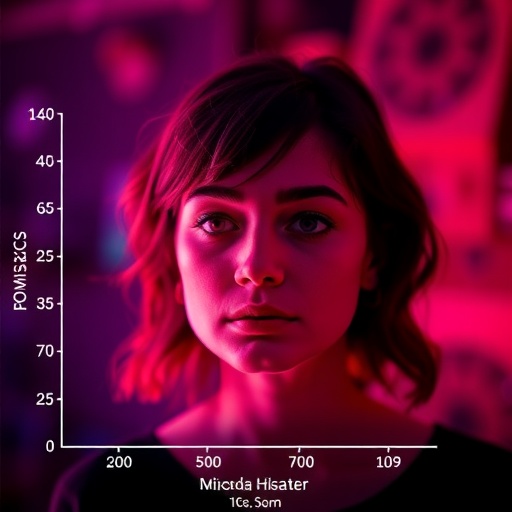In a groundbreaking new study published in BMC Psychiatry, researchers have delved into the elusive biochemical factors underlying mood disorders, focusing on the hypothalamic neuropeptides proopiomelanocortin (POMC) and neuropeptide Y (NPY). These molecules, which play critical roles in regulating appetite, stress response, and emotional states, are gaining recognition as potential biomarkers for differentiating between unipolar depression and bipolar disorder, two conditions that often present overlapping clinical symptoms but require distinct therapeutic strategies.
Mood disorders, encompassing major depressive disorder and bipolar disorder, represent a significant global health burden due to their chronic nature and profound impact on quality of life. Despite decades of psychiatric research, the pathophysiology remains incompletely understood, hindering the development of precise diagnostic tools. This study by Solak and Gokcen aims to bridge that gap by quantitatively measuring peripheral serum levels of NPY and POMC in patients diagnosed with either bipolar disorder or unipolar depression, juxtaposed against healthy controls.
NPY and POMC are neuropeptides synthesized in the hypothalamus, a brain region integrally involved in maintaining homeostasis and emotional regulation. NPY is predominantly known for its potent orexigenic effect, stimulating appetite and food intake, but it also modulates anxiety and stress resilience. Conversely, POMC-derived peptides generally suppress appetite and influence energy expenditure, while also modulating mood and neuroendocrine functions. By examining alterations in these peptides, the study explores their potential mechanistic roles in the dysregulated affective states seen in mood disorders.
The study cohort consisted of 54 patients, including 28 with bipolar disorder and 26 with unipolar depression, alongside 27 healthy control subjects. Blood samples were collected to quantify serum concentrations of NPY and POMC through advanced immunoassay techniques. Concurrently, participants underwent standardized clinical assessments using the Hamilton Depression Rating Scale (HAM-D), the Epworth Sleepiness Scale, and the Three-Factor Eating Questionnaire. These tools enabled a multifaceted evaluation of depressive symptoms, sleep patterns, and changes in eating behavior, providing a comprehensive clinical context for interpreting neuropeptide levels.
Strikingly, the research revealed that both bipolar and unipolar patients exhibited significantly lower serum levels of NPY and POMC compared to the control group, with p-values underscoring robust statistical significance. This reduction underscores a potential hypoactivity within hypothalamic neuropeptide systems in mood disorders, aligning with prior animal and human studies implicating disrupted neuropeptide signaling in affective dysfunction. The data suggest that diminished NPY and POMC may be intrinsic features of mood disorder pathology, rather than merely epiphenomena of symptom severity.
Interestingly, when comparing the two patient groups directly, NPY levels were observed to be lower in the unipolar depression cohort relative to the bipolar group, although this trend did not reach statistical significance. Conversely, POMC levels showed a pattern of greater reduction in the bipolar group than in those with unipolar depression, again without significant statistical difference. These nuanced variations hint at differential neuropeptide dysregulation across mood disorders; however, larger studies are necessary to confirm and elucidate these distinctions definitively.
Another notable finding was the absence of any significant correlations between neuropeptide levels and clinical scale scores, including measures of depressive severity, sleepiness, and eating behaviors. This lack of association could imply that peripheral NPY and POMC concentrations are more reflective of underlying pathophysiological changes than moment-to-moment symptom fluctuations. It also highlights the complexity of mood disorders, where neurobiological markers do not always parallel clinical presentation in a straightforward manner.
Perhaps most intriguing is the study’s pioneering exploration of how these neuropeptides intersect with alterations in eating behavior among depressed patients. Appetite and weight changes are hallmark features of mood episodes, yet the biochemical underpinnings have remained elusive. By implicating NPY and POMC in these behavioral changes, the research opens new avenues for understanding metabolic and mood disorder comorbidity, potentially leading to targeted interventions that address both affective and metabolic dysregulation concurrently.
From a broader perspective, this research advances the conceptualization of mood disorders as multisystem diseases involving neuroendocrine and metabolic pathways. It underscores the necessity for biomarker-driven psychiatry, where objective molecular measures can augment clinical evaluation, ultimately refining diagnosis and personalized treatment. The findings also resonate with the emerging field of psychoneuroimmunology, suggesting that hormone-like neuropeptides serve as critical mediators linking psychological stress, brain function, and systemic physiology.
While promising, the study acknowledges limitations including the modest sample size and cross-sectional design, which preclude causal inferences. Longitudinal studies tracking neuropeptide fluctuations over the course of illness and treatment could provide richer insights into their role as state versus trait markers. Moreover, investigating central nervous system levels alongside peripheral measurements would clarify the neurobiological relevance of serum concentrations.
Looking forward, integrating neuropeptide profiling with cutting-edge genomic, proteomic, and neuroimaging modalities could transform our ability to dissect the heterogeneity of mood disorders. Therapeutic development may also capitalize on modulating NPY and POMC pathways, offering novel pharmacologic targets. Ultimately, this research emphasizes the profound interplay between neuroendocrine function and mental health, heralding a future where mood disorder management is informed by precise biological signatures.
As mental health continues to claim unprecedented attention worldwide, studies like this illuminate the path toward unraveling the intricate biochemical tapestry of psychiatric illnesses. The evaluation of POMC and NPY levels not only deepens our mechanistic understanding but also provides a scaffold for future innovations in diagnosis, treatment, and perhaps prevention of debilitating mood disorders that affect millions.
Subject of Research: Evaluation of hypothalamic neuropeptides proopiomelanocortin (POMC) and neuropeptide Y (NPY) in bipolar and unipolar depression patients, assessing their role as potential biomarkers and their association with eating behavior and mood disorder pathophysiology.
Article Title: Evaluation of Proopiomelanocortin (POMC) and neuropeptide Y (NPY) levels in bipolar and unipolar patients
Article References:
Solak, H., Gokcen, O. Evaluation of Proopiomelanocortin (POMC) and neuropeptide Y (NPY) levels in bipolar and unipolar patients.
BMC Psychiatry 25, 707 (2025). https://doi.org/10.1186/s12888-025-07147-x
Image Credits: AI Generated




